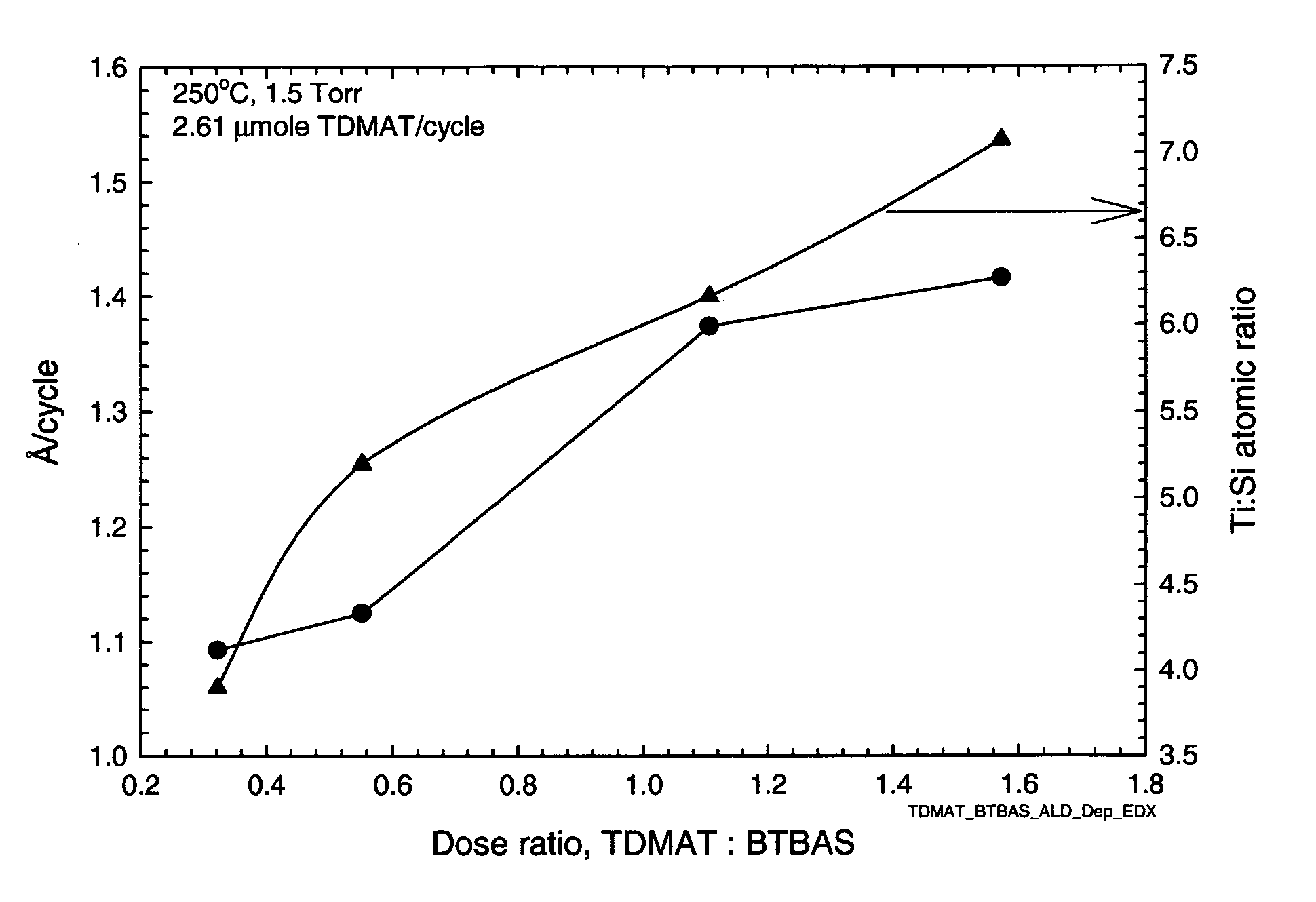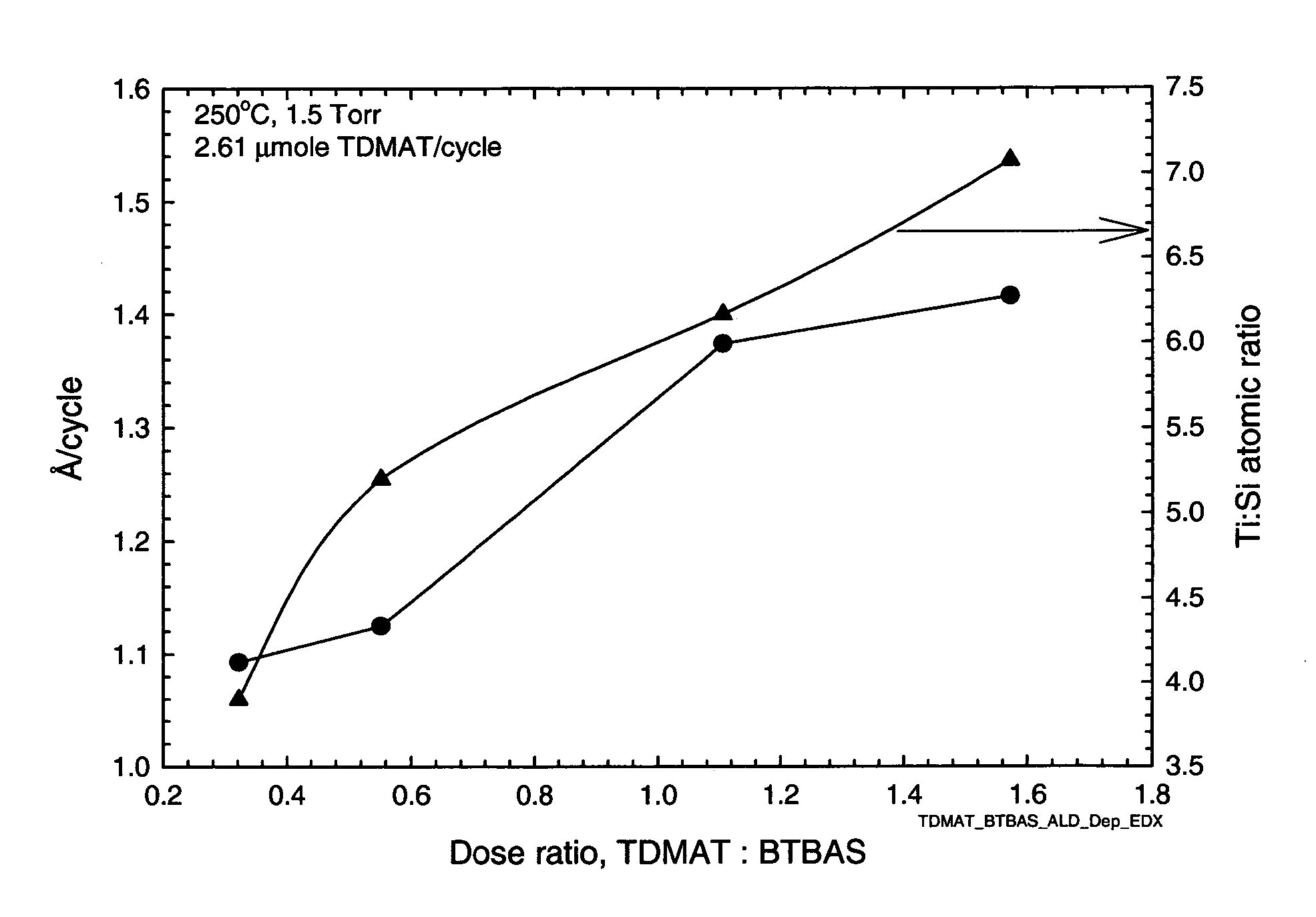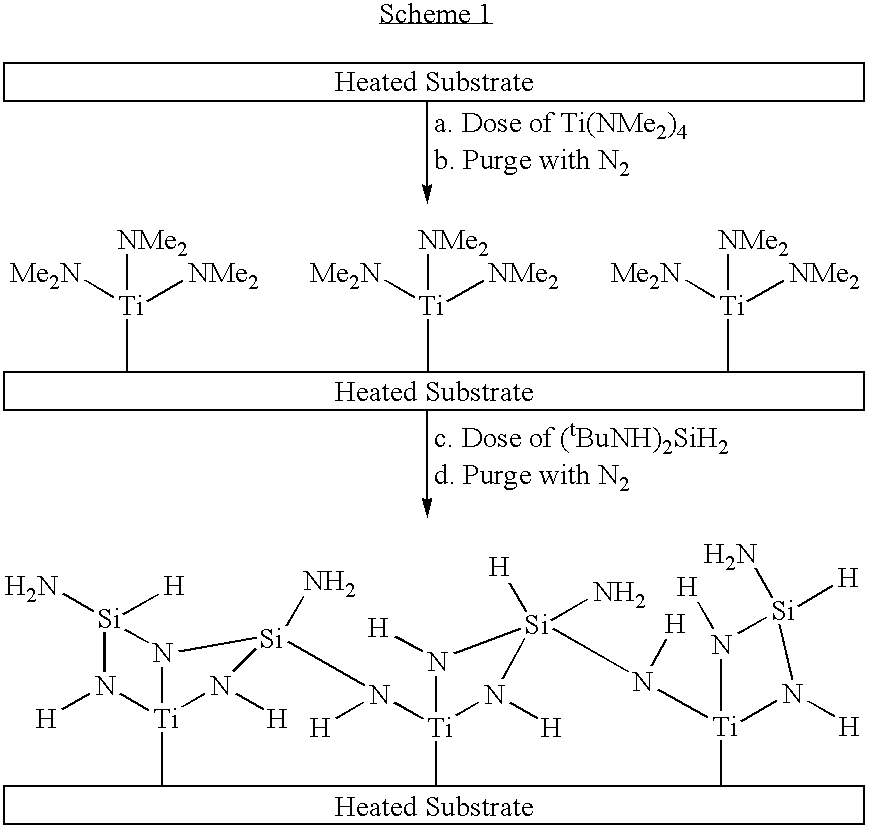Preparation of metal silicon nitride films via cyclic deposition
a metal silicon nitride and cyclic deposition technology, applied in the field of metal silicon nitride films via cyclic deposition, can solve the problems of difficult to achieve the barrier performance of copper diffusion, affecting the performance of devices, and affecting the stability of films, etc., and achieve the effect of increasing film stability
- Summary
- Abstract
- Description
- Claims
- Application Information
AI Technical Summary
Benefits of technology
Problems solved by technology
Method used
Image
Examples
example 1
Deposition of TiSiN Films from TDMAT and BTBAS at 200° C.
[0062] A silicon wafer is charged to a deposition chamber and maintained at a temperature of 200° C. and a pressure of 200 Pa (1.5 Torr). A Ti-containing compound of 2.6 micromoles, tetrakis(dimethylamino)titanium (TDMAT), is introduced into the chamber over a period of 10 seconds pulse along with 100 sccm N2. After deposition of the Ti amide, the unreacted Ti amide and byproducts are purged with 2000 sccm N2 for 7.5 seconds. Then, a dose 4.73 micromoles of a Si-containing compound, bis(tert-butylamino)silane (BTBAS), is introduced over a period of 80 seconds along with 100 sccm N2. Unreacted BTBAS and byproduct are removed by a 40 second purge with 2000 sccm of N2.
[0063] The above cycle is repeated for 200 cycles (of the 4 steps) and a film of 45 Å thickness is generated. The deposition rate per cycle is 0.22 Å which is much lower than a typical ALD process, showing this temperature is insufficient for these precursors to a...
example 2
ALD Formation of TiSiN Films from TDMAT and BTBAS at 250° C.
[0064] The procedure of Example 1 is followed except that the silicon wafer is maintained at a temperature of 250° C. and a pressure of 200 Pa (1.5 Torr). A Ti-containing compound of 2.6 micromoles, tetrakis(dimethylamino)titanium (TDMAT) is introduced for 10 seconds into the chamber with 100 sccm N2. A purge of 2000 sccm N2 follows for 7.5 seconds. Then a dose 4.73 micromoles of a Si-containing compound, bis(tert-butylamino)silane (BTBAS), is introduced for 80 seconds along with 100 sccm N2. This is followed by a 40 second purge with 2000 sccm of N2. The cycle was repeated for 100 cycles (of the 4 steps) and a film of 144 Å thickness was generated.
[0065] The deposition rate per cycle is 1.44 Å which falls in the range for a typical ALD process, showing this temperature is sufficient to achieve monolayer surface saturation. The Ti to Si molar input ratio is 0.55 and the Ti to Si atomic ratio in the deposited film is analy...
example 3
Cyclic CVD Formation of TiSiN Films from TDMAT and BTBAS
[0067] The procedure of Example 1 is followed except the silicon wafer is maintained at a temperature of 300° C. and a pressure of 200 Pa (1.5 Torr). A Ti-containing compound of 2.6 micromoles, tetrakis(dimethylamino)titanium (TDMAT), is introduced for 10 seconds into the chamber with 100 sccm N2. A purge of 2000 sccm N2 follows for 7.5 seconds. Then a dose 4.73 micromoles of a Si-containing compound, bis(tert-butylamino)silane(BTBAS), is introduced for 80 seconds along with 100 sccm N2. This is followed by a 40 second purge with 2000 sccm of N2. This is repeated for 100 cycles (of the 4 steps) and produces a film of 629 Å thickness. The rate per cycle is 6.29 Å, showing this temperature is too high to limit deposition to a monolayer per cycle. In contrast to Examples 1 and 2, a cyclic CVD-like process occurred at this temperature, leading to a deposition rate much higher than in an ALD process.
[0068] The Ti to Si molar input...
PUM
| Property | Measurement | Unit |
|---|---|---|
| temperature | aaaaa | aaaaa |
| pressure | aaaaa | aaaaa |
| temperature | aaaaa | aaaaa |
Abstract
Description
Claims
Application Information
 Login to View More
Login to View More - R&D
- Intellectual Property
- Life Sciences
- Materials
- Tech Scout
- Unparalleled Data Quality
- Higher Quality Content
- 60% Fewer Hallucinations
Browse by: Latest US Patents, China's latest patents, Technical Efficacy Thesaurus, Application Domain, Technology Topic, Popular Technical Reports.
© 2025 PatSnap. All rights reserved.Legal|Privacy policy|Modern Slavery Act Transparency Statement|Sitemap|About US| Contact US: help@patsnap.com



